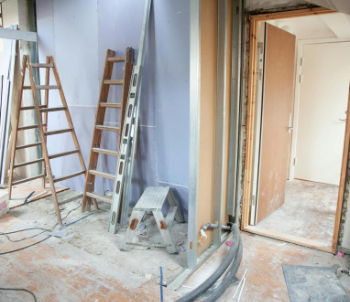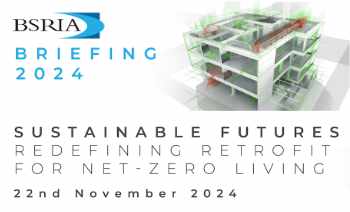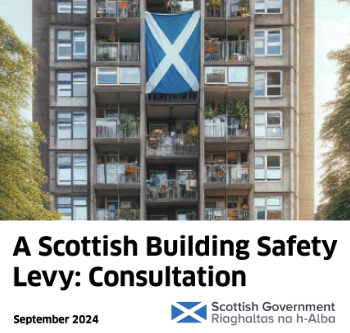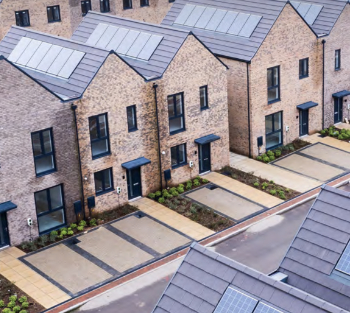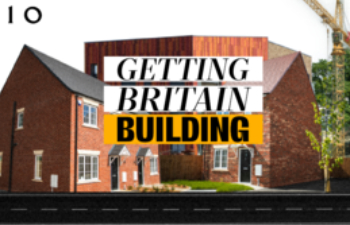Embodied carbon
‘Climate Emergency Design Guide: How new buildings can meet UK climate change’, published by the London Energy Transformation Initiative (LETI) in January 2020 defines embodied carbon (EC) (or embedded carbon) as:
‘The carbon emissions associated with the extraction and processing of materials and the energy and water consumption used by the factory in producing products and constructing the building. It also includes the ‘in-use’ stage (maintenance, replacement, and emissions associated with refrigerant leakage) and ‘end of life’ stage (demolition, disassembly, and disposal of any parts of product or building) and any transportation relating to the above.’
It defines upfront embodied carbon as:
‘The carbon emissions associated with the extraction and processing of materials, the energy and water consumption used by the factory in producing products, transporting materials to site, and constructing the building.’
And whole life carbon (WLC) as including:
‘… embodied carbon, as defined above, and operational carbon. The purpose of using WLC is to move towards a building or a product that generates the lowest carbon emissions over its whole life (sometimes referred as ‘cradle-to-grave’).’
Embodied carbon may also be referred to as embodied emissions.
NB Redefining value, The manufacturing revolution, Remanufacturing, refurbishment, repair and direct reuse in the circular economy, published by the United Nations Environment Programme in 2018, suggests embodied material emissions: ‘Refers to the carbon dioxide and greenhouse gas equivalent emissions emitted during the extraction and primary processing stages of materials later used as inputs to OEM New and value-retention process production activities; ‘cradle-to-gate’ up until entering the production facility ‘gate’. Modeling of embodied material emissions uses a material-specific conversion (kgCO2-eq./unit), based on the global average for each material type, in accordance with the Inventory of Carbon and Emissions (ICE) (Hammond and Jones 2011).’
Embodied Carbon, The Inventory of Carbon and Energy (ICE), By Prof. Geoffrey Hammond and Craig Jones, Ed. Fiona Lowrie and Peter Tse, published by BSRIA in 2011, states embodied carbon (EC) is: ‘…the sum of fuel related carbon emissions (i.e. embodied energy which is combusted – but not the feedstock energy which is retained within the material) and process related carbon emissions (i.e. non-fuel related emissions which may arise, for example, from chemical reactions). This can be measured from cradle-to-gate, cradle-to-grave, or from cradle-to grave.’
[edit] Related articles on Designing Buildings
- An in-depth look at Environmental Product Declarations EPDs.
- BPIE report urges EU to incorporate the carbon footprint of construction into policy.
- BS EN 15978-1.
- BSRIA Whitepaper on Embodied Carbon NZG 4/2023
- Carbon dioxide.
- Carbon footprint.
- Climate change act.
- Climate change science.
- Climate Emergency Design Guide.
- Cradle to grave.
- Dr. Natasha Watson; UK lead for embodied carbon at Buro Happold.
- Embedded carbon emissions.
- Embodied energy.
- EN 15804+A1 2012.
- Environmental product declaration EPD.
- Greenhouse gas.
- Life Cycle Carbon Emissions.
- Mandatory and optional environmental impact categories.
- Optional environmental impact categories.
- PHribbon tool calculates embodied carbon of designs.
- Product Environmental Footprint PEF.
- Product category rules PCR.
- RICS launches new global edition of its ground-breaking Whole Life Carbon Assessment standard.
- Sustainable procurement.
- Sustainability in building design and construction.
- The sustainability of construction works.
- Upfront emissions.
- Use stage embodied carbon.
- Wood, embodied carbon and operational carbon.
- Whole life carbon.
Featured articles and news
Considerate Constructors Scheme acquires Building A Safer Future
Acquisition defines a new era for safety in construction.
AT Awards evening 2024; the winners and finalists
Recognising professionals with outstanding achievements.
Reactions to the Autumn Budget announcement
And key elements of the quoted budget to rebuild Britain.
Chancellor of the Exchequer delivers Budget
Repairing, fixing, rebuilding, protecting and strengthening.
Expectation management in building design
Interest, management, occupant satisfaction and the performance gap.
Connecting conservation research and practice with IHBC
State of the art heritage research & practice and guidance.
Innovative Silica Safety Toolkit
Receives funding boost in memory of construction visionary.
Gentle density and the current context of planning changes
How should designers deliver it now as it appears in NPPF.
Sustainable Futures. Redefining Retrofit for Net Zero Living
More speakers confirmed for BSRIA Briefing 2024.
Making the most of urban land: Brownfield Passports
Policy paper in brief with industry responses welcomed.
The boundaries and networks of the Magonsæte.
London Build Fire and Security Expo
20-21 Nov and now with new Ambassador Programme..
The Scottish Building Safety Levy
Eight weeks of consultation closing on 18 November.
The grey, the brown and the golden rules of housing
shifting policies from the wild west of housing development.
Future proofing homes that are fit for purpose
Specification challenges and the role of plastic.
Thousands of new homes unlocked for brownfield sites
£68 million to 54 councils for neglected land into new homes.














